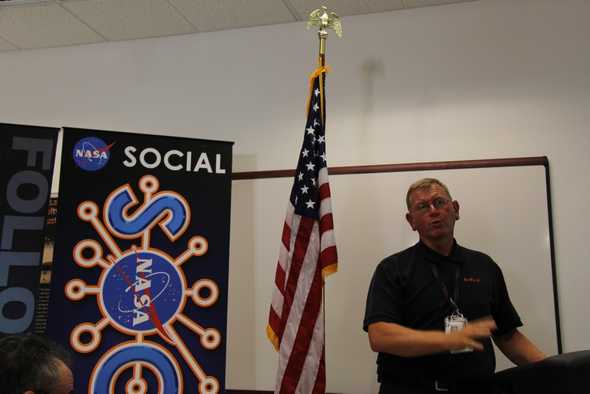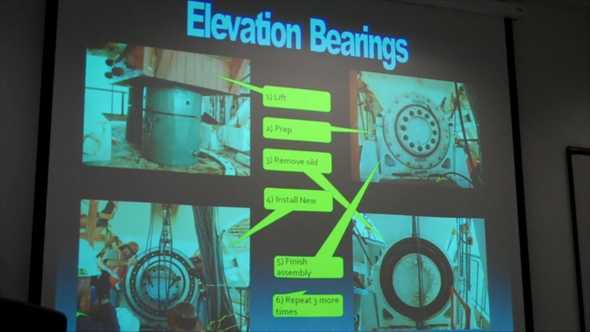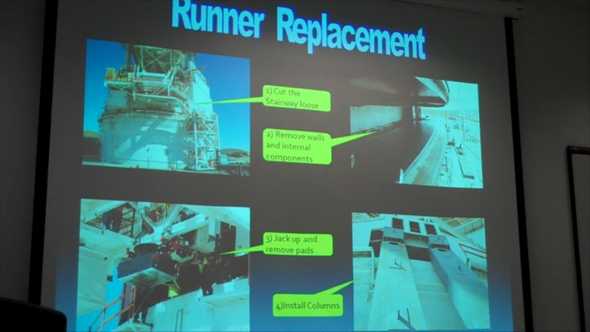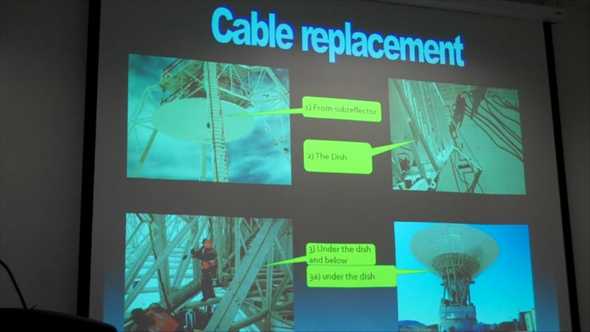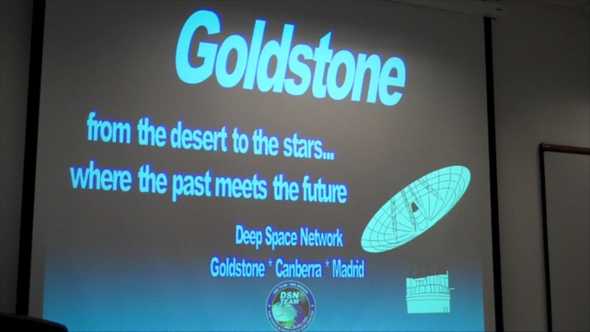Goldstone #DSN: Robert Haroldsson
Robert Haroldsson, Antenna & Servo Maintenance Manager at ITT Exelis DSN, spoke to us at the Goldstone Deep Space Network NASA Social about the massive repairs they did in 2010. He was the manager of the Depot Level Maintenance and Life Extension for the 70 meter DSS-14 antenna.
It took nearly a year and a half to plan this job. The Jet Propulsion Laboratory, who built the equipment, assisted in the planning and repair. Major tasks included replacing the elevation and hydrostatic bearings (also known as the runner) and cables. During the repairs, the antenna was taken offline and not used. It was estimated to cause a downtime of eight months.
Elevation bearings allow the antenna to tilt up and down. On each end of the central axle, there is a yoke containing a bearing. They used two jacks to lift each end of the axle about a quarter of an inch, one side at a time. They pumped hydraulic fluid behind the bearing, building enough pressure to pop the bearing off. Using a crane, they removed and replaced the bearings with new ones. There were a total of four bearings that had to be replaced.
The next task was to replace the hydrostatic bearing, or runner, by lifting approximately seven million pounds and removing the damaged grout. The runner allows the antenna to rotate left and right. The hydrostatic bearing glides on oil thousandths of an inch thick. Oil had seeped into the joints and caused the grout to deteriorate throwing the three floating pads out of alignment.
They had to remove stairs, cut away walls, and remove internal components around the steel runner. There are eleven segments of the runner that make up a donut shape that had been used for 44 years. On top of the runner rest three pads that the upper rotating structure floats on. They installed three 22,000 pound columns that supported the area where each pad was located.
When they removed the heavy steel runners, they used a piece of equipment called an air caster. Interestingly, they discovered these from a YouTube video where a pickup truck was lifted and could be pushed by humans. Using the air casters, they saved a lot of time by being able to move each segment over to the crane. This prevented a very time consuming process that moved the crane for each segment.
After the segments were removed, the grout was exposed. Using jackhammers, they removed the grout that had been penetrated by oil through little cracks that had formed over time. They used epoxy grout that is impervious to oil. After mixing the compounds, they had only two to three hours to work with it. A hardender and resin were mixed for five minutes and then poured into a cement mixer with sand. The mix was transported in buckets. They performed this task at night and Haroldsson couldn’t believe how many bugs there were.
Each segment of the runner weighs about 22,000 pounds. Each joint between the segments couldn’t have a gap even a hair’s thickness wide. Twelve bolts on the top of the runner attached the two segments to a splice plate with wedges for adjustments and 16 more bolts on the side.
The grout had to be carefully poured so that it would ooze under and throughout the L-shaped void around the soul plates. It took about an hour to finish the first segment.
When they replaced the runners, they changed the height of the steal runners from five inches to seven inches. This meant they had to remove two inches from the pads so the antenna would remain at the same level.
The last piece of maintenance was replacing cables that were 400 feet long from the main control room on top of the antenna down to the base. By repairing the cables, they saved a lot of money by preventing future problems and the potential for downtime.
Along with people with STEM careers, Harroldson said the DSN also needs people who are skilled in machining and people who can pull the hydraulics apart. Maintenance is a never ending project at the DSN.
Haroldsson stressed that the Deep Space Network stresses worker safety. Workers were always harnessed during the repairs and while performing maintenance. He said when the workers are working around large equipment like these antennas, they want to make sure they go home at the end of the day. They plan how they are going to perform tasks and what safety equipment, including a fall protection harness, are necessary to keep everyone safe.
Here is the video of Haroldsson talking about the repairs:

